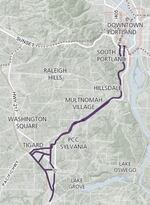
The TriMet Max picks up passengers in downtown Portland.
Katelyn Black / OPB
There’s more than one measure on Oregon’s ballot with $1 billion worth of implications.
The statewide initiative Measure 97 would enter the multi-billion dollar range with its proposed increased taxes on companies with more than $25 million in annual sales in Oregon. But the future of a $2.5 billion light rail project hangs in the balance, too.
The proposed Southwest Corridor light rail line could reach 12 miles, making it the longest light rail line built in the region in 20 years. The northeast end would be close to where I-405 goes under Portland State University. It would extend west and south to Bridgeport Village — the mall on the edge of Tualatin.
The goal is to solve traffic problems in Portland neighborhoods like Hillsdale and Multnomah Village, and get people out of their cars on Highway 99W and I-5, as well as provide another way to access Oregon Health and Science University, Portland Community College and Portland State University.

Planners published a map in October 2016 of possible alternative routes for the proposed Southwest Corridor light rail line from Portland to Tualatin.
Metro Council / Metro
The reason Tigard voters are weighing in dates back to a charter change city voters approved two years ago, making the city opposed to light rail through town unless a vote of the people approved the line.
Tigard is getting the "vote of the people" they asked for: Measure 34-255.
It doesn’t relate to light rail funding. It would give permission for light rail to come through the city of Tigard, particularly along city streets, regardless of who’s paying for it.
If the project continues to move forward, officials in the region have said it’s likely a funding package would come before voters — and not just in Tigard.
Critics question whether the line would actually reduce congestion. They argue buses are more flexible and cheaper. Some people don’t appreciate the housing density that often comes with transit projects.
And some question the return-on-investment of the $2.5 billion cost, particularly since sometimes fewer passengers than anticipated use the high-cost transit lines.
The project has already run into some cost limitations. The project’s steering committee has abandoned the possibility of building tunnels to access the Sylvania hilltop campus of Portland Community College.
Arguments in the Voters Pamphlet against the measure come from some people who say they live or work along the line. They also come from ideological opponents, like the libertarian think tank Cascade Policy Institute.
“TriMet and Metro are promoting the idea of a new light rail line from Portland State University to Bridgeport Village shopping mall in Tualatin. The question is: ‘who would ride it?’ We already know from experience that mall shoppers prefer private cars to trains,” said the institute’s president, John Charles, in a recorded commentary.
Supporters argue the line is serving much more than the mall. It’s for people all over the southwest suburbs to connect to downtown Portland, PSU, PCC and points in between.
Former Tigard Mayor Craig Dirksen — now a Metro councilor representing Tigard — has a particular argument for his anti-growth constituents.
“For folks who are concerned about light rail and say I’m going to vote ‘no,’ because I don’t want Tigard to change. If they vote ‘no,’ Tigard as a city will be required to change, to meet the needs of future growth,” Dirksen said. “Whereas it can be accommodated much more compactly if we pass this and allow light rail to come down through those areas.”
As for the cost argument, half of this is would be federal funds, which can only be spent on transit projects, so it can’t just be re-routed onto roads and highways, for instance.
Finally, the bus question. Those routes are cheaper to build, but tend to be more expensive to operate. Regional planners went with light rail for the Southwest Corridor, but rapid buses on the east side for the Powell-Division transit effort.
If Measure 34-255 passes, planners will continue. They’re headed into environmental review and more specific work on where various stops will go.
If it fails, then Councilor Dirksen says the steering committee has a few options. It could still go through Tigard, but on state highway facilities. Or, it could go around Tigard, though doing that would mean going through Clackamas County and Lake Oswego. But those areas have been skeptical of transit — light rail and street car lines — in the past.
A failure by the measure would almost definitely slow the project down and drive up the cost, if it wouldn’t kill it outright.

